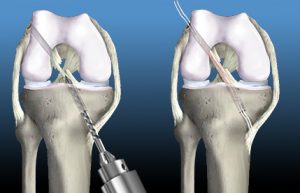Anterior cruciate ligament (ACL) injuries often require reconstruction and repair of this fibrous structure. ACL reconstruction involves the use of a graft to replace the damaged ligament. The most common grafts used come from the patient’s own body, such as one of the hamstring tendons or the patellar tendon (from the kneecap region). A less commonly used graft is called an allograft, where tissue is taken from a deceased person.
Repair of the ACL also is done in the case of an avulsion fracture, which involves separation of the ligament and a segment of the bone from the rest of the bone. With this procedure, the bone fragment is connected to the ACL and then reattached to the bone.
ACL reconstruction surgery is done by making tiny incisions in the knee to insert an arthroscope and small instruments. The scope allows the Phoenix orthopedic surgeon to visualize the region, and the instruments allow removal of tissue and bone, repair, and reconstruction. For serious injuries, the physician must perform open surgery, where a large incision is made on the knee.
Arthroscopic Surgery Outcomes
Many orthopedic specialists prefer arthroscopic surgery rather than open surgery because of the positive outcomes for the patient. These include:
- Uses smaller incisions than open ACL surgery.
- Easier to visualize and work on the knee structures.
- Can be done as a diagnostic and repair procedure, which the scope is used to see the ACL damage.
- Has fewer risks and complications than open surgery.
- Can be done under general or regional anesthesia.
- Has quicker recovery time.
What to Expect After Surgery
Following arthroscopic ACL reconstruction surgery, the patient usually goes home the same day. This outpatient procedure means that there is no overnight stay and lengthy hospitalization. The patient will wear a knee brace for a few days and be prescribed crutches. The weight-bearing instructions will depend on the type of surgery performed.
The knee will be swollen, tender, and slightly numb at the incision areas. Also, the patient will feel tired and can have bruising and swelling of the ankle, shin, and/or knee. Most of these symptoms go away within two to five days. The incision must be kept clean and dry while it heals, and the patient is instructed on the signs and symptoms of infection.
Physical Rehabilitation
For a full recovery following ACL reconstruction surgery, the patient can expect this to take around three to six months. The length of time depends on the general health of the patient, the extent of damage to the knee, and the expertise of the surgeon. The patient usually visits a physical therapist to learn  strengthening exercises.
strengthening exercises.
Rehabilitation is done to restore range of motion of the knee between 0 degrees (straight) and 130 degrees (flexed or bent). This is important so the patient can walk normally without mobility issues.
Risks and Complications
Very few people who have ACL reconstruction continue to have knee pain and instability following the procedure. If there are problems and complications, the orthopedic specialist may need to do a revision ACL surgery to repair and correct issues and problems that occur. Regardless, ACL reconstruction surgery is safe and effective. The complications that can arise during the recovery period include:
- Numbness of the surgical scar area.
- Blood clots in the leg.
- Infection of the surgical incisions.
- Damage to the blood vessels, nerves, and/or structures around the knee.
- Usual risk of anesthesia.
- Loosening, re-injury, stretching, or scar tissue of the graft tendon.
- Limited range of motion of the knee.
- Grating (crepitus) of the kneecap with movement.
- Painful knee with athletic activities.
Other Things to Consider
Surgery immediately after an injury is associated with arthrofibrosis, which results in increased fibrous tissue and loss of knee motion. For this reason, ACL reconstruction is often delayed for a few weeks so swelling can decrease and inflammation can reside. The success of ACL surgery is dependent on the orthopedic surgeon skill and preference more so than the type of graft used. There are many techniques of attaching and reconstructing grafts.



